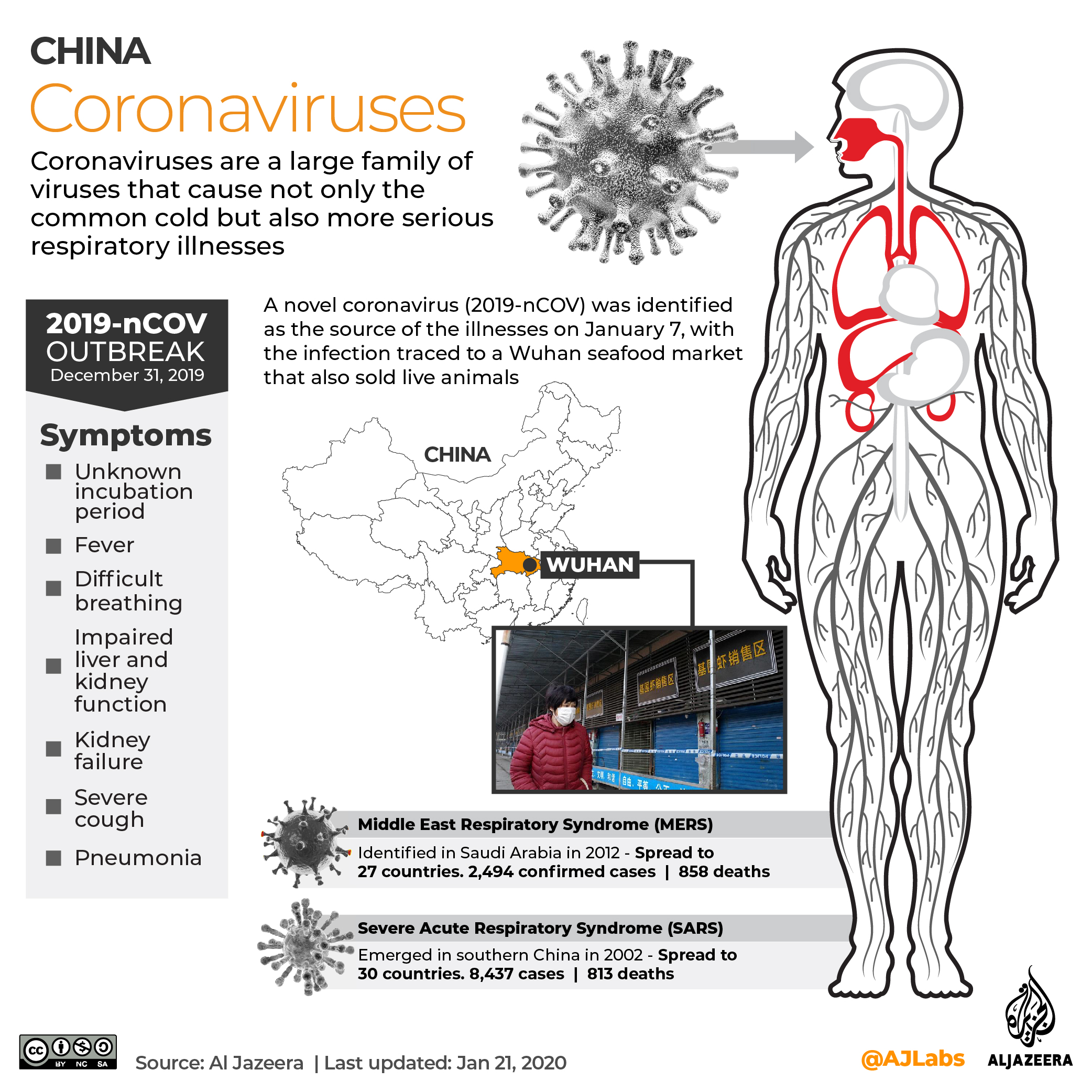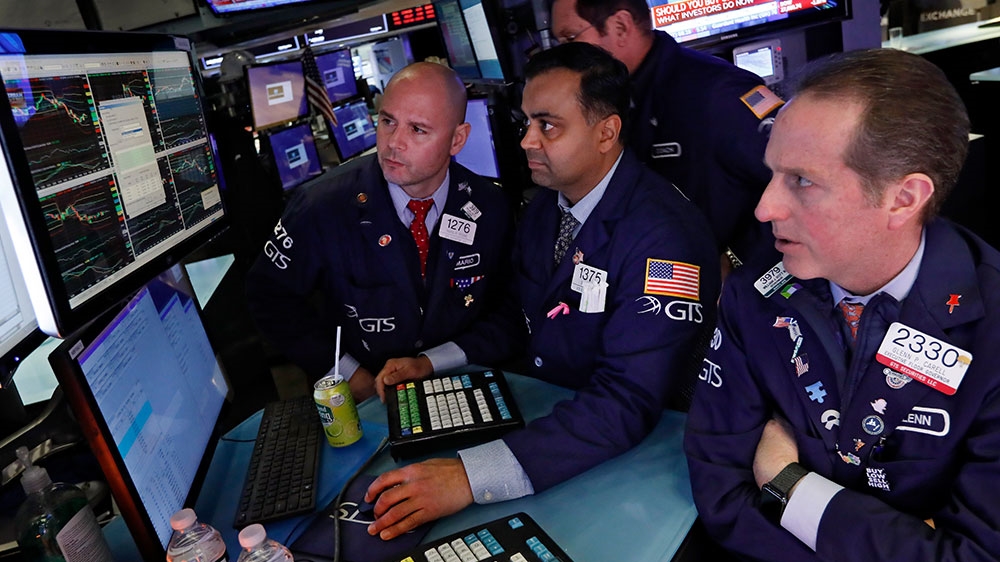US reports worrisome new coronavirus case as Trump urges calm
Democrats slam Trump for his response as new coronavirus case in California could be first community transmission in US.

US President Donald Trump declared that a widespread US outbreak of the new respiratory virus sweeping the globe is not inevitable even as top health authorities at his side warned Americans that more infections are coming.
Shortly after Trump spoke on Wednesday, the government announced a worrisome development: Another person in the US is infected with the novel coronavirus – someone in California who does not appear to have the usual risk factors of having travelled abroad or being exposed to another patient.
Keep reading
list of 3 itemsCoronavirus: Which countries have confirmed cases?
What happens if you catch the new coronavirus?
At a White House news conference, Trump sought to minimise fears as he insisted the US is “very, very ready” for whatever the COVID-19, as the novel coronavirus is officially known, outbreak brings. Under fire about the government’s response, he put Vice President Mike Pence in charge of coordinating the efforts, a move slammed by the Democrats.
“This will end,” Trump said of the outbreak. “You don’t want to see panic because there’s no reason to be panicked.”
But standing next to him, the very health officials Trump praised for fighting the new coronavirus stressed that schools, businesses and individuals need to get ready.
“We do expect more cases,” said Dr Anne Schuchat of the Centers for Disease Control and Prevention (CDC).
If the CDC confirms that the latest US case does not involve travel or contact with an infected person, it would be a first in this country and a sign that efforts to contain the virus’ spread have not been enough.
“It’s possible this could be an instance of community spread of COVID-19,” the CDC said in a statement.

More than 81,000 cases of COVID-19, an illness characterised by fever and coughing and in serious cases shortness of breath or pneumonia, have occurred since the new virus emerged in China.
Trump spent close to an hour on Wednesday discussing the virus threat, after a week of sharp stock market losses in response to the health crisis, which he blamed on Democrats, and concern within the administration that a growing outbreak could affect his re-election.
Trump acknowledged that the outbreak could “have an impact on GDP” but insisted that the US economy is still “doing great”.
‘Not a question of if, but when’
A key question is whether the Trump administration is spending enough money to get the country prepared – especially as the CDC has struggled to expand the number of states that can test people for the virus. Other key concerns are stockpiling masks and other protective equipment for health workers, and developing a vaccine or treatment.
Health officials have exhausted an initial $105m in emergency funding and have been looking elsewhere for dollars.
Earlier this week, Trump requested $2.5bn from Congress to fight the virus. Senate Democratic Leader Chuck Schumer of New York countered with a proposal for $8.5bn. Senate Majority Leader Mitch McConnell said on Thursday that he expects the chamber to take up funding legislation within the next two weeks.

Trump told reporters he was open to spending “whatever’s appropriate”.
Trump compared the new virus repeatedly to the flu, which kills tens of thousands of people each year. On Wednesday, World Health Organization chief Tedros Adhanom Ghebreyesus said Trump was “right” to advise people to take preventive measures against the coronavirus similar to those against the flu, but he added COVID-19 is not influenza and with the right measures it can be contained.
The new coronavirus has killed more than 2,700 people – most in China and none in the US – but scientists still do not understand who’s most at risk or what the death rate is. There are more than a dozen confirmed cases in the US, in addition to 45 cases among individuals repatriated to the country.
Without a vaccine, the CDC’s Schuchat advised people to follow “tried and true, not very exciting” but important precautions: Wash your hands, cover your coughs and stay home when you’re sick.
A day earlier, another CDC official, Dr Nancy Messonnier, was even more blunt, telling Americans to get ready for some of the same steps as occurred during the 2009 flu pandemic, such as school closings. “It’s not so much a question of if this will happen any more, but rather more a question of exactly when this will happen – and how many people in this country will have severe illness,” she said.
The National Institutes of Health’s top infectious disease chief cautioned a vaccine will not be ready for widespread use for a year or more. But Dr Anthony Fauci said even if the virus wanes soon, it’s “quite conceivable” that it might “come back and recycle next year.” By then, he said, “we hope to have a vaccine.”
Democrats slam Trump response, Pence appointment
Democrats were quick to continue to criticised Trump’s response to the outbreak. House Speaker Nancy Pelosi on Wednesday called it “opaque and chaotic”.
“The Trump Administration has left critical positions in charge of managing pandemics at the National Security Council and the Department of Homeland Security vacant,” she said in a statement.
“The Trump Budget called for slashing almost $700 million from the Centers for Disease Control,” she added. “And even now, the Administration continues to devalue Americans’ health security by ransacking funding from other vital public health needs.”
Democratic Representative Bennie Thompson, chairman of the House Homeland Security Committee, criticised Trump’s appointment of Pence as the official to lead the response.
Putting Pence, “someone with no public health expertise, in charge of the response will not instill confidence with the American people and raises questions about the administration’s ability to coordinate an effective response to a complex public health threat.”

During his time as Indiana’s governor, Pence faced criticism for his response to a public health crisis in the southern part of the state.
In 2015, Scott County saw the number of people infected with HIV skyrocket, with nearly 200 people testing positive for the virus in a span of months. Indiana law at the time prohibited needle exchanges, exacerbating the outbreak, which primarily infected intravenous users of the painkiller Opana.
Pence had long opposed needle exchanges but was eventually persuaded to issue an executive order allowing one in Scott County. Despite his own misgivings – Pence said he did not support the exchanges as an “anti-drug policy” – he signed a law allowing the state government to approve them on a case-by-case basis.
Trump in 2014 criticised then-President Barack Obama’s appointment of Ron Klain to oversee the US response to the Ebola outbreak.
“Obama just appointed an Ebola Czar with zero experience in the medical area and zero experience in infectious disease control,” Trump tweeted at the time. “A TOTAL JOKE!”